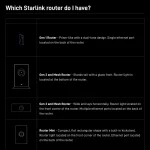The 2024 Electricity Costs of Big UK ISP Home Broadband Routers UPDATE

Some years ago we examined the electricity costs of running a modern Home Broadband connection (here), which largely reflected the price of keeping your wireless internet router (or modem) switched-on around the clock. Given the issue of energy costs, we thought it might be worth seeing how this has changed.
Back in 2017 people were paying around 12 to 20 pence per 1 kWh (1,000 Watts per hour) consumed (daytime) and some setups also applied a cheaper nighttime rate, but to save time our estimates were based on the roughly middling rate of 15.5p (pence) per 1kWh of usage. We also opted to exclude the daily standing charge (currently c.53.35 pence per day), since it wasn’t directly connected to the amount of energy consumed by a router.
Since then, the cost of electricity has surged upwards at a shocking pace, although – mercifully – it has started to come down from the 2022 peak, due to a number of reasons that we aren’t going to explore today. The result is that many people have found themselves stuck on standard variable tariffs, which for the sake of argument – and based largely on the January 2024 energy price cap – will charge you around 28.62p per kWh of electricity used (varying between different regions, operators and plans).
Advertisement
The following thus represents somewhat of an updated view of the current costs, which looks at the consumption of the latest router models – those supplied by the biggest broadband ISPs – and also considers the impact of Optical Network Terminals (ONT or UNO), which are currently being installed as part of modern Fibre-to-the-Premises (FTTP) connections.
At this point it’s worth noting that some consumers may feel a desire to switch-off their routers at night to save power. But we’d generally caution against this due to the number of inter-dependent network devices that may be connected to a modern home network (e.g. security alarms, cameras, solar PV systems, mobile phones etc.).
In addition, most people still connect via broadband connections that involve some old copper wiring, such as ADSL, VDSL2 (FTTC / SOGEA) and G.fast. As a general rule, you should avoid switching these on and off a lot because the network operator’s Dynamic Line Management (DLM) system may detect it as a fault, which could drop your line speeds as the connection attempts to find more stability.
Router Features vs Performance
Hopefully it goes without saying that the amount of power a router draws will vary and is dependent upon both the device specification (chipset used, CPU performance etc.) and how much it’s being used at any given time (across WiFi, Ethernet links, firewalls etc.). For example, the WiFi service alone on your router may gobble anything from a few hundred milliwatts and up to 2-3 Watts at peak.
Advertisement
This is why most router manufacturers tend to specify figures for both IDLE consumption (i.e. when the device is operating but not doing much, such as when you’re asleep at night) and LOAD (i.e. when multiple devices are active on your network and moving data at fast speeds). The way manufactures define IDLE and LOAD figures can vary a bit (i.e. different methodologies for testing), but they’re still a reasonable guide.
Some people also use the Power Supply Unit (PSU) figures for routers as a gauge for understanding usage, but this is unwise as PSUs are designed to be able to cope with significantly more electricity than the device itself would typically use (plenty of overhead). In other words, don’t put too much stock in the old Volts x Amps = Watts calculation as a reflection of the router’s real-world consumption.
In addition, a router will only run so fast before you can’t do much more, and it ends up throttling the CPU (impacting your performance) or simply overheating, which may occur before the device itself reaches the max PSU rating. Supply and demand decisions can also impact the manufacturer’s PSU choice, which further divorces this part from actual device consumption.
In our summary we’ve opted to use official IDLE and LOAD figures, but where we couldn’t uncover the correct data we’ve used feedback from end-users to determine the likely consumption. All of these should be considered as estimates because we all use our networks in different ways.
Advertisement
Comparing Power Usage on Major ISP Routers
Before we get started, it’s important to consider the change in broadband value and thus efficiency. Modern routers have to cope with much more powerful and significantly faster WiFi, Ethernet and broadband connections (e.g. FTTC vs FTTP), but at the same time the chipsets and CPUs being used inside these devices have become much more energy efficient. Not to mention that the broadband connections themselves are also more efficient.
The above helps to explain, at least in part, why upgrading to a ten times faster internet connection than you had before doesn’t mean you’ll use ten times more electricity. In fact, even if the latest routers do use a bit more power than the models from 2017, you might still find that your overall electricity usage falls via other devices (e.g. computers) because you won’t have to leave them switched-on as long to conduct big downloads etc.
For example, TalkTalk’s old “Super Router” (HG635) from 2017 gobbled 6 Watts at IDLE and 10 Watts at LOAD. By comparison, the provider’s latest “Wi-Fi Hub 2” (Sagemcom F@st 5464) router consumes 7.29W at IDLE and 10.6W at LOAD, which is despite the fact that the latest model is much more capable than the older kit and is often used with faster broadband connections.
Click over to read page 2 and see the power and cost figures..
Mark is a professional technology writer, IT consultant and computer engineer from Dorset (England), he also founded ISPreview in 1999 and enjoys analysing the latest telecoms and broadband developments. Find me on X (Twitter), Mastodon, Facebook, BlueSky, Threads.net and Linkedin.
« Age UK Claim 2.3 Million People Aged 65+ Still Don’t Use the Internet






















































So, people are worried about something in the region of 7p a day. Getting a bit silly isn’t it?
Slow news day
Aye, The amount of people who used to whine to me about speed drops on ADSL/FTTC but admitted they turned the router off overnight to “save a bit of power” was insane. I bet these people drink smoke and do other stuff which far outweighs the router power!
Oddballs the lot of them!
A lot of effort put in to basically say don’t worry about it, it’s nothing in the scheme of things, 50p a week.
I’m glad Mark did the research and decided to share it with us.
Sorry you were underwhelmed by the facts on this occasion.
Hi Mark,
Is there anything that can be done about these ads? It’s fairly annoying when you get half way through an article only for the page to refresh due to the ads on the page then having to scroll down to where you were. I also have had issues when I’m typing a comment only for the page to refresh and having to start all over again.
Regards
I get at least 3 crashes per page…it’s very annoying
My mobile browser fragments when trying to read an article – very annoying.
My little Pi-Hole takes care of all the nasty little ads….
And in line with the article, it uses very little power…
adblockplus – 0 power requirements 🙂
No Virgin Hub 3 data. A lot of us are still using this even though the Hub 5 is out.
I’ve measured mine with a calibrated power meter. It varies quite a bit depending on configuration (modem mode vs. router), VoIP telephony enabled or not, etc. With everything on I measured similar numbers to the SH4.
Yeah I was wondering what modem only mode on thd SH routers would be and I have a SH3. I already know that my PFsense router uses 8W as I measured the difference between it and the old m-itx Sandybridge based PC that I used (40W) to use to work out how long it would take to pay off the hardware in saved electric costs).
Just switch it off we need to go green betrer air stop leaving it on 24/7 no point the same you don’t leave your tv switched on 24/7 a day.
1. I do, I leave mine on standby who cares I can afford it.
2. The TV does not affect the transmitter’s power – A router will trigger DLM and kill the speed as the exchange will think there is a possible fault.
3. They are not remotely even widely relevant to each other.
A TV takes a few seconds to turn on, a router can take upwards of a minute or two. It’d be like going back to the dial-up days waiting for it to connect whenever you want to use it.
There are better and more meaningful ways to save energy and money than turning routers off. I do think this article serves a purpose in demonstrating how little energy they use in the context of a househould annual energy bill.
If you have a VOIP landline (and at the end of next year nearly everyone who wants a landline will) you won’t be turning off the router.
Why switch it off? I think if people need to save the cost that a router or router and ONT cost to run, then they are not going to have the internet in the first place.
If I turned mine off, then my VoIP, Alexas, outdoor cameras, thermostat and other things would also go off-line.
Anyway, with ADS; and FTTC it can cause problems.
While bending over to unplug mine I farted, now I have no internet and the air stinks, you lied.
For comparison, Starlink costs roughly 30p a day.
Mind uses about 40W when idle and around 101W when downloading – and you are correct.
For someone with Starlink you had quite a moan about being stuck on FTTC a couple of days back.
£35 a year is actually pretty good. Not really sure what the point of this article is. This plus ads. Site is going downhill
The point is that just because you aren’t interested, many people are.
I might add that you’ve apparently taken the time to whine that you’ve read a clearly titled article that isn’t of interest to you. If you’ve got that much time to spare then I’m sure there’s other high value uses for your time and commenting skills, such as repeats of Cash in the Attic, Bargain Hunt, decades old editions of Homes under the Hammer, and Police Interceptors featuring footage from 1994.
This completely shows that routers spend far too much cash therefore it’s much better to have them turned off!!
Not if you have a VOIP landline it isn’t.
Recent Utility costs prices may be no problem for the chunter heads in employment on average income and above (Who said average incomes in the Chancellor’s Surrey constituency ?) but for the rest of us . . . especially pensioners . . . its a different story
Still switch my router off at night and all the other kit on stand-by and if the refrigerators were made to a decent standard of insulation, I’d do that as well. The USB emergency/camping lights/Keyboard LEDS, in combination work a treat at anything between 2 and 4.5W an hour.
And after the gas central and water heating went phut, switched that off and rely on “On-demand” kettles and plug-in wall heaters.
Combined Electricity and Gas bill now well below the cap by several hundred pounds a year and comfort level unaffected, in fact localised thermostatically controlled heating is better and I have no need of a “Smart meter” and continue to refuse their frequent “Offers” (Who wants their limited personal cash flow disrupted by incorrect billing and randon date direct debiting when power costs are this high ?).
Horses for courses
As a pensioner, “Every little helps” . . especially this year as they’ve left the Income Tax personal allowance frozen.
Turning a fridge off overnight makes no difference to energy consumption as it just has to cycle on for longer to bring the box down to temperature when the power comes back on. If you’re happy to have your food stored at a higher temperature then adjust the thermostat rather than letting it warm up overnight. Since the heat removed from the box ends up on the radiators at the back to add heat to your kitchen, there are few appliances more efficient.
Both my parents are pensioners and they aren’t worried about money spent on utilities. Why? They have a smart meter and reduced cost tariff from octopus. They also take part in savings sessions. All their lighting is LED. You don’t need to go to such extremes for a few pence savings. Shop around.
The only time I’ve ever had billing issues was when I was on a standard meter due to “estimated” readings and then not being able to read the meter themselves. My smart meter has been entirely reliable.
Thanks to things like far more generous private and occupational pensions than most under 50 could dream of, housing costs and other things the average pensioner is now better off than the average person in work.
This ignoring the huge wealth gap and only focusing on disposable income.
Boomer generation will on average receive £130k more from the taxpayer than they put in throughout their lifetime. This alongside the enormous and entirely unearned wealth, again subsidised by those younger, largely for being born at the right time.
The chunter heads on average incomes and above subsidise the rest, especially pensioners.
“but for the rest of us . . . especially pensioners . . . its a different story”
Given the stonking pension rises under the triple lock, plus the various giveways like Warm Home Discount, Winter Fuel Payment, the one off Pensioner Cost of Living payment, I’m only hearing a very, very small violin. My elderly mother certainly spent her winter fuel payment on fuel. Jet fuel, for a month’s break in Australia.
Those of us still working are getting pay rises a fraction of the triple lock, stuff all help with bills, and watching our pensionable age recede into the future.
The article says about the usage at idle and at load, how on earth do you get a router to get up to the max?
Getting my router to stream a few things on different devices only got it to 40% CPU usage from 22%, it did go to 70% for a few seconds. Memory went from around 30% to 53%, and it made no difference whatsoever to power usage.
Still 16 watts, that is including the Echo unit, thermostat hub, a 4 port switch and a Zigbee hub as well as the router, but it did not change at all.
Dont use a router as speeds here are sub 10mbps but do use a mobile upto 100mbps.
Anyway, Just looking at the PC connected to the Watt Meter and its pulling 650w.
Ohh well.
If you don’t use a router, how do you connect your PC to the net or do you tether it to your phone?
One of the reason I decided to go for a Mac mini is because it uses less energy, when I am just doing stuff like this, it idles at around 10 watts, sometime Less, even at fall pelt it may hit 100 now and again. My Ryzen 7 1700 PC, will use over 150 when it is doing nothing.
I have to add on my monitors, which I use with both machines and I have a hub with two drives in for the Mac, but I doubt that takes much.
IT ALWAYS PUZZLES ME HOW FOLKS LOOK AT ENERGY BILLS.
A WATT IS A MEASURE OF ENERGY PER UNIT TIME OR 1 JOULE PER SECOND.
MORE WATTS EQUATES TO MORE ENERGY PER SECOND, OR HOUR ETC.
A KILOWATT-HOUR IS NOT KILOWATTS PER HOUR. IT IS THE PRODUCT: KILOWATT MULTIPLIED BY TIME. ARITHMETICALLY THIS BRINGS US BACK TO ENERGY.
ENERGY IS WHAT WHAT WE ALL GET BIILED-FOR (GAS OR ELECTRIC). WE PAY FOR THE NUMBER OF KILO-JOULES IN EFFECT.
AN ANALOGY IS TORQUE WHICH IS NEWTON-METRE, NOT NEWTON PER METRE AS SOME PEOPLE SAY.
Don’t shout.
Are you angry? No need to shout.
I know how to work out how much a device cost me to run, and we get charge by kWh, but the more watts a device use, the more it will cost to run.
I get it a kettle will use a lot of watts, but is only on for a couple of minutes, where a computer will use less, but is on for much longer.
The BT Smart Hub 2 I have, it if wasn’t being used for data transmission could be marketed as one of them ceramic plug-in electric fires. In winter its very warm and in summer can be too hot to touch. That’s wasted energy.
On the issue of the refrigerators, I think they are appaulingly designed, manufactured and insulated and the cooling effect is generally concentrated on the back-wall only – witness my under-counter, freestanding larder fridge. At the slightest provocation it will ice-up the back wall in summer when set on 70-80% of maximum, which is just enough to keep the cabin temperature near 10C. Without better cooling distribution (By a fan or cold sink “Arms” projecting up the sides), the thing will ice-up quickly necessitating the use of a pin hammer to take-off 3 solid inches of ice off the back wall after 6 weeks use between defrosts. My current larder (7 years old) came fitted as new with an incandescent cabin light and that was fitted in a blister which protruded inside the cabin and reduced storage space (Light was swapped out for LED PDQ). And the ones on sale today are all the same. Dreadful. Consumer goods designers . . . . Quanqueres (As Steve Bell’s Frenchman character would say).
I notice a friend’s EE router gets hot, very hot, in the summer it was a wonder it did not go pop.
something is no right in there, as you said, that is wasted energy. Their contract is up in a few months, and they are changing to ZZoomm, so they can get rid of it.
As for fridges, I though modern ones had better insulation, I got a new freezer last year and that certainly have better insulation than my old one and is frost free.
The fridge/freezer I have also got is a few years old now and while the insulation is not as good as the new unit, it has auto defrost for the fridge and have never froze up since i had it, but I do have to remember to poke something down the hole at the back now and again, otherwise it will get blocked and then water will leak into the fridge. The freezer part do need to be defrosted now and again.
when it goes belly up I will just get a fridge, i don’t need two freezers.
@Mark
Many thanks for this article. I religiously follow all of the news articles on this site but I also really enjoy these more journalistic articles.
This one covers something that I hadn’t really thought about and provided context that I will use in the future.
I appreciate your efforts.
Observations
1/ Would be useful to compare if 4G/5G broadband (to a fixed router) was similar wattage. e.g. Three 5G. At a guess I would expect a higher usage as such equipment is running more transmitters (Wifi side and 5g/4g side).
One might expect a MiFi hub to be a lot less power hungry (if plugged in permanently) but also wouldn’t handle the same workload
2/ To an extent, in the winter, heat dissipation from any tech in the home will corresponding reduce central heating demand to keep the room warm. Yes that tech driven heating may be using more expensive electric to replace gas (or coal, wood, or cheaper storage heater elec). So turning tech equipment off may not be saving as much as is often portrayed
3/ All electronics are “reactive” load (which current electric meters under-record, but future smart meters may be configured to accurately record), not resistive load. Volts x Amps = Watts calc is only accurate resistive load, and thus all the figures for the survey will be a few % out (on the low side). The correct calculation is more nuanced and needs more specialist measurement, and may or mauy not have been correctly assessed in published figures.
Not material in most cases, I agree.
NB I have always felt there was a potential market for distributed cloud computing located in/near domestic/commercial buildings where the waste heat from the cloud servers could be put to good use most of the year. The arrival of high speed FTTP would make this viable, if it could be packaged sensibly and securely (combined heat pump and cloud cabinet perhaps).
To clarify–distributed cloud computing (with a possibility of heat recovery) is now possible for bigger businesses, e.g. a shipping container in a car park to hold the servers, with the servers joined into a public cloud (i.e. Amazon AWS Outpost or Azure HCI) but exclusively used by the company funding the equipment and power. Or used as bare metal for private cloud/virtualised server farm.
But there is a significant barrier to entry, need to be a medium sized business to be able to procure, install and operate such equipment.